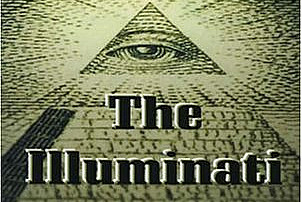Full Body Scanners
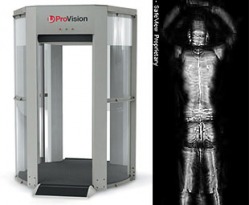
Security checkpoint full body scanners. The full body scanner is not new, but it is needless to say that the concept of a full body x-ray doesn't sit too well with many people. The scanners are currently being tested at 10 different US airports, but the trial only involves offering the scanner as an alternative to a pat down in a secondary security search. The obvious question is whether the scanner can see "everything", and the answer is yes - the full body scanner will see all your "parts", the TSA tries to alleviate passenger concerns by moving the screener away from the machine, hidden away in a dark room. Your face is also blurred on the display, so there is no risk of TSA agents pointing at you while giggling like little school girls. Sadly, the truth is that the full body scanner is probably here to stay, and will eventually become the way all passengers are scanned at the airport. There is no denying that the ability to see right through you and your clothes is the most effective way to scan for weapons or other unwanted items at the airport. Whether this technology will also involve you walking through with your bags is just a matter of time.
"[The New World Order] cannot happen without U.S. participation, as we are the most significant single component. Yes, there will be a New World Order, and it will force the United States to change it's perceptions." -- Henry Kissinger, World Affairs Council Press Conference, Regent Beverly Wilshire Hotel , April 19th 1994
"[The New World Order] cannot happen without U.S. participation, as we are the most significant single component. Yes, there will be a New World Order, and it will force the United States to change it's perceptions." -- Henry Kissinger, World Affairs Council Press Conference, Regent Beverly Wilshire Hotel , April 19th 1994
Biometric Digital Fingerprint Scanner
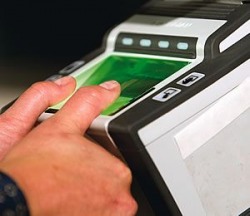
Biometric technology, requiring digital fingerprints and a photograph for identification, is used by the Department of State to establish and verify the identities of visa applicants at embassies and consulates around the world through its BioVisa program. The Department of Homeland Security established the US-VISIT program under which a traveler’s biometrics are collected in his country, compared against a watch list of known criminals and suspected terrorists, and then verified again upon arrival in the United States. Biometrics are unique and virtually impossible to forge.
Video Surveillance Gets Smarter
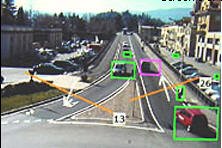
Video surveillance gets smarter in Verbania, Italy
Verbania, the capital of the province of Verbano-Cusio-Ossola, Italy, was created when the towns of Intra and Pallanza merged. As one of the most idyllic and famous tourist destinations on Lake Maggiore, the town relies heavily on holidaymakers to fill its streets and generate income. To ensure the safety of visitors and citizens, the town council decided to launch a community surveillance project based on a system of network cameras. Monitors linked to the ten Sony SSNC-RX550 network cameras are installed in the Verbania Municipal Police control room, which is currently undergoing restructuring. Even so, the system does not require the intervention of dedicated security operatives. The human element only comes into play when real-time monitoring is needed (for example during a major event), or when an automatic alarm is triggered. The town's network cameras have been positioned so that they can monitor all arrival and escape points in every area of the town. Intelligent image analysis functions now enable allow the city to keep special areas such as no-stopping zones under control. Using these features, live images can be monitored in unattended mode until suspicious activity occurs, at which point the operator is proactively alerted to the threat by means of an appropriate alarm.
“And I believe it will be said of this age, the first decades of the 21st century, that out of the greatest restructuring of the global economy, perhaps even greater than the industrial revolution, a new world order was created.” “For the first time in human history we have the opportunity to come together to create a new global covenant and a true global society.” Gordon Brown, Current British Prime Minister
Verbania, the capital of the province of Verbano-Cusio-Ossola, Italy, was created when the towns of Intra and Pallanza merged. As one of the most idyllic and famous tourist destinations on Lake Maggiore, the town relies heavily on holidaymakers to fill its streets and generate income. To ensure the safety of visitors and citizens, the town council decided to launch a community surveillance project based on a system of network cameras. Monitors linked to the ten Sony SSNC-RX550 network cameras are installed in the Verbania Municipal Police control room, which is currently undergoing restructuring. Even so, the system does not require the intervention of dedicated security operatives. The human element only comes into play when real-time monitoring is needed (for example during a major event), or when an automatic alarm is triggered. The town's network cameras have been positioned so that they can monitor all arrival and escape points in every area of the town. Intelligent image analysis functions now enable allow the city to keep special areas such as no-stopping zones under control. Using these features, live images can be monitored in unattended mode until suspicious activity occurs, at which point the operator is proactively alerted to the threat by means of an appropriate alarm.
“And I believe it will be said of this age, the first decades of the 21st century, that out of the greatest restructuring of the global economy, perhaps even greater than the industrial revolution, a new world order was created.” “For the first time in human history we have the opportunity to come together to create a new global covenant and a true global society.” Gordon Brown, Current British Prime Minister
CyberExtruder Gets 2D to 3D Face Patent>
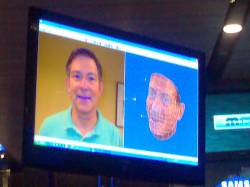
CyberExtruder announced that the company had been granted a new patent on their process for creating reliable 3D models of a person’s face from a single or series of 2D images. CyberExtruder’s 2D-to-3D conversion is certainly an important innovation to the security and biometrics technology industries. Why? It enables better matching between offline photographs and surveillance video. While the matching of "watch list" images against surveillance video has traditionally achieved mixed results as a result of inadequate lighting, angle, expression, etc., this patent could signify a leap forward in terms of the quality and value of 3D facial images.
New York City Police Department's Surveillance Helicopter
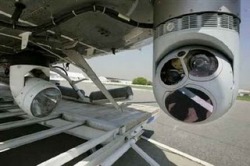
According to the NYPD, you won't even recognize that its there, but high above the heads of New York City's citizens, there is a $10 million special NYPD helicopter with an impressive arsenal of surveillance equipment inside it. The chopper, called "23", looks like plain helicopter on the outside, but on the inside it is chock-full of hi-tech gadgetry. The helicopter's surveillance cameras, including one for infrared photography, are mounted below the aircraft. The chopper's arsenal of sophisticated surveillance and tracking equipment is powerful enough to stealthily read license plates - or even pedestrian's faces - from high above. The helicopter's surveillance system can beam live footage to police command centers or even to wireless hand-held devices. Without leaving Manhattan airspace, the chopper also was able to get a crystal-clear picture of jetliners waiting to take off from LaGuardia Airport and to survey Kennedy International Airport's jet fuel lines. The helicopter is just part of the department's efforts to adopt cutting-edge technology for its counterterrorism operations. The NYPD also plans to spend tens of millions of dollars strengthening security in the lower Manhattan business district with a network of closed-circuit television cameras and license-plate readers posted at bridges, tunnels and other entry points.
Echelon (Signals Intelligence)
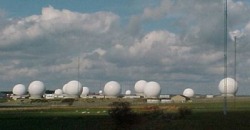
“Trillions of bytes of textual archive and thousands of online users, or gigabytes of live data stream per day that are filtered against tens of thousands of complex interest profiles” Echelon is a system used by the United States National Security Agency (NSA) to intercept and process international communications passing via communications satellites. It is one part of a global surveillance systems that intercept messages from the Internet, from undersea cables, from radio transmissions, from secret equipment installed inside embassies, or use orbiting satellites to monitor signals anywhere on the earth's surface. The system includes stations run by Britain, Canada, Australia and New Zealand, in addition to those operated by the United States. They all form part of the same integrated global network using the same equipment and methods to extract information and intelligence illicitly from millions of messages every day, all over the world. The system works by indiscriminately intercepting very large quantities of communications and using computers to identify and extract messages of interest from the mass of unwanted ones. A chain of secret interception facilities has been established around the world to tap into all the major components of the international telecommunications networks. Some monitor communications satellites, others land-based communications networks, and others radio communications. ECHELON links together all these facilities, providing the US and its allies with the ability to intercept a large proportion of the communications on the planet. The computers at each station in the ECHELON network automatically search through the millions of messages intercepted for ones containing pre-programmed keywords. The thousands of simultaneous messages are read in "real time" as they pour into the station, hour after hour, day after day, as the computer finds intelligence needles in telecommunications haystacks. According to its website, the USA's National Security Agency is "a high technology organization... on the frontiers of communications and data processing". Russia, China, France and other nations also operate worldwide networks.
"What is at stake is more than one small country, it is a big idea - a new world order...to achieve the universal aspirations of mankind...based on shared principles and the rule of law...The illumination of a thousand points of light...The winds of change are with us now". George Herbert Walker Bush
"What is at stake is more than one small country, it is a big idea - a new world order...to achieve the universal aspirations of mankind...based on shared principles and the rule of law...The illumination of a thousand points of light...The winds of change are with us now". George Herbert Walker Bush
Enhanced Driver’s Licenses
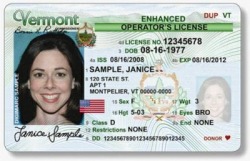
Vermont has become the third state to begin issuing enhanced driver’s licenses with radio frequency tags that also serve as official identification cards at U.S. border crossing points. It did so under a program authorized by the Homeland Security Department. The Vermont Department of Motor Vehicles began accepting applications for the enhanced licenses through its Montpelier office. The new card is voluntary and costs $25 more than a standard license. New York, Washington State and British Columbia in Canada offer similar licenses designed to comply with DHS’ Western Hemisphere Travel Initiative, which goes into effect in June, 2009. Officials in Arizona, Michigan, Manitoba, Ontario and Quebec have indicated they intend to issue similar cards. The enhanced drivers licenses have embedded radio frequency identification (RFID) chips that can be scanned at a distance of 20 to 30 feet at U.S. border crossings. The RFID chips in the licenses emit a reference number that must be checked against a DHS database to obtain personal information.
Peering Beneath the Skin
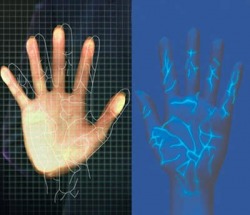
Like that of a fingerprint, the pattern of blood veins in the palm is unique to every individual. Unlike a fingerprint, however, the palm has a biometric pattern that is virtually impossible to duplicate. So Fujitsu developed a palm reader that checks the blood vessels under the skin -- and people don't even have to touch the device. That alleviates concerns about hygiene, especially in hospitals, where many people touch the same biometric sensors to gain access to a room or storage cabinet.
RFID tattoos for tracking cows... and people

Did you know that Saint Louis based Somark Innovations successfully tested an "RFID tattoo" on cows and rats? Yes indeed, tattoo, not the ol' RFID chip found in passports, dogs, and Dutch VIP clubbers. Somark's system uses an array of needles to inject a passive RFID ink which can be read through the hair on your choice of beast. The ink can be either invisible or colored but Somark is keeping mum as to its exact contents. They only say that it doesn't contain any metals and is 100% biocompatible and chemically inert. The tattoo can be applied in 5 to 10 seconds with no shaving involved and can be read from up to 4 feet away -- the bigger the tattoo, the more information stored. Best of it all, it's apparently safe for humans to ingest allowing the FDA to track back Mad Cow Disease, e-coli outbreaks, and Soylent Green. Don't worry, they can't track you just as long as you chew your food like mama taught. However, with "military personnel" listed as Somark's "secondary target market," well, it's just a matter of time before we're all cattle now isn't it.
Hitachi Finger Vein Scanner
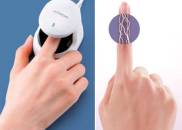
This is a new payment technology brought to us by Hitachi which makes your fingertip pay for transactions. This is a biometric cardless credit payment system, which adopts the uniqueness of the blood vessel patterns in each individual human body as the signature for payment authentication. The new biometric system is able to recognize pattern of the blood vessels in your fingers, so, what you need is to insert your finger for a scan to authenticate the credit card transactions. Blood vessels are hidden under the skin, which aren’t like retinas or fingerprints and shouldn’t be possible to counterfeit. In order for you to use your fingertip for making payment, you need to first register your finger vein pattern with the credit card company. The idea of cardless payment making use finger vein that has lowest counterfeit possibility is definitely good. A few of the common problems such as card loss and theft will be eliminated with this new system.
"For more than a century ideological extremists at either end of the political spectrum have seized upon well-publicized incidents such as my encounter with Castro to attack the Rockefeller family for the inordinate influence they claim we wield over American political and economic institutions. Some even believe we are part of a secret cabal working against the best interests of the United States, characterizing my family and me as 'internationalists' and of conspiring with others around the world to build a more integrated global political and economic structure--one world, if you will. If that's the charge, I stand guilty, and I am proud of it." - David Rockefeller's Memoirs (Random House, New York, 2002)
"For more than a century ideological extremists at either end of the political spectrum have seized upon well-publicized incidents such as my encounter with Castro to attack the Rockefeller family for the inordinate influence they claim we wield over American political and economic institutions. Some even believe we are part of a secret cabal working against the best interests of the United States, characterizing my family and me as 'internationalists' and of conspiring with others around the world to build a more integrated global political and economic structure--one world, if you will. If that's the charge, I stand guilty, and I am proud of it." - David Rockefeller's Memoirs (Random House, New York, 2002)
U.K. To Begin Microchipping Prisoners
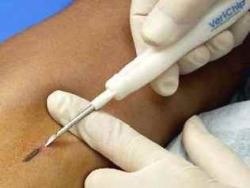
The British government is developing a plan to track current and former prisoners by means of microchips implanted under the skin, drawing intense criticism from probation officers and civil rights groups. As a way to reduce prison crowding, many British prisoners are currently released under electronic monitoring, carried out by means of an ankle bracelet that transmits signals like those used by mobile phones. Now the Ministry of Justice is exploring the possibility of injecting prisoners in the back of the arm with a radio frequency identification (RFID) chip that contains information about their name, address and criminal record. Such chips, which contain a built-in antenna, could be scanned by special readers. The implantation of RFID chips in luggage, pets and livestock has become increasingly popular in recent years.
In addition to monitoring incarcerated prisoners, the ministry hopes to use the chips on those who are on probation or other conditional release. By including a satellite uplink system in the chip, police would be able to use global positioning system (GPS) technology to track subjects' exact locations at all times. Click Here - to see a Rfid Chip image with details on individual parts.
Face Scan
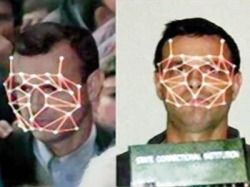
A computer that could recognize faces as readily as people can and would make the ideal aid for spotting and tracking known terrorists and criminals on streets or in transportation stations. But face-recognition systems aren't as reliable as law-enforcement officials would like. Identix (IDNX) and other suppliers are making steady progress. Identix says that, by combining the usual face scan with an inspection of pores and wrinkles in small blocks of skin, reliability is improved by at least 25%, to better than 90%.
National ID Card
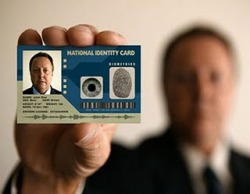
National Id Cards - Does an increase in identification really lead to increased security or is it an invasion of our privacy? The advance of identification technology biometrics, rfid chips, identity cards, surveillance, databases, dossiers threatens privacy, civil liberties, and related human interests. Since the terrorist attacks of September 11, 2001, demands for identification in the name of security have increased. A national ID represents a transfer of power from individuals to institutions, and that transfer may threaten our liberty, subject people to unwanted surveillance and a uniform, government-controlled identification system.
"The technotronic era involves the gradual appearance of a more controlled society. Such a society would be dominated by an elite, unrestrained by traditional values. Soon it will be possible to assert almost continuous surveillance over every citizen and maintain up-to-date complete files containing even the most personal information about the citizen. These files will be subject to instantaneous retrieval by the authorities." –Zbigniew Brzezinski. founder of The Trilateral Commission.
"The technotronic era involves the gradual appearance of a more controlled society. Such a society would be dominated by an elite, unrestrained by traditional values. Soon it will be possible to assert almost continuous surveillance over every citizen and maintain up-to-date complete files containing even the most personal information about the citizen. These files will be subject to instantaneous retrieval by the authorities." –Zbigniew Brzezinski. founder of The Trilateral Commission.
Iris Scan
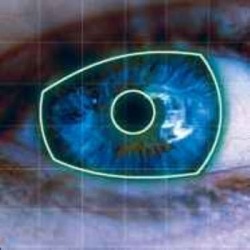
The Eyes Have It. Probably the most foolproof biometric measure is the eye's iris. Its complex pattern of zigzagging lines and random dots is much more distinctive than the whorls of a fingerprint. In fact, because authorities in a few foreign countries are confident that iris scans can't be circumvented, they're starting to allow airlines to use iris scanning at selected airports. If people register their iris scans, they can bypass the usual security check. Currently, a person's eye must be in close to the scanner. Intelligence and law-enforcement agencies hope that some way can be found to scan irises from a distance -- or even to spot a suspect in a crowd.
